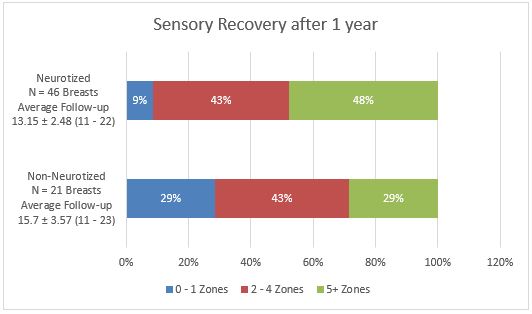Sensory Recovery after 1 Year from a Multi-Center Propective Outcomes Registry
Galen Perdikis, MD, Vanderbilt University Medical Center, Nashville, TN, Matthew Chetta, MD, FACS, The Ohio State University, Columbus, OH, Suhail Kanchwala, MD, University of Pennsylvania, Philadelphia, PA, Frank Lau, MD, Louisiana State University Health Sciences Center, New Orleans, LA and Arash Momeni, MD, Stanford University Medical Center, Palo Alto, CA
Background
Sensory restoration has been described as the next frontier in autologous breast reconstruction. Despite successful reports, flap neurotization has not yet become widely adopted, partly due to substantial heterogeneity in surgical technique and study design. The Sensation Neurotization Outcomes in Women (Sensation-NOW) study is a multi-center prospective outcomes registry to evaluate flap neurotization, return of sensation, and its impact on short and long-term patient-reported outcomes after autologous breast reconstruction in a standardized manner. We report on clinical findings at 1 year following neurotization.
Methods
This IRB-approved registry has been initiated at 15 centers to date. Patients who underwent autologous reconstruction with and without flap neurotization were enrolled. Neurotization was performed via coaptation of a sensory branch of T10-12 to T3-4 using a nerve allograft. Standardized sensory assessments using Semmes-Weinstein Monofilament (SWMF) or Pressure Specified Sensory Device were completed at 9 test zones at postoperative time intervals (i.e. Early (0-3M), Mid (5-7M), Annual (11-13M), Late (17-19M), Final (23-26M)). Clinically meaningful sensation was defined as pressure <100(g/mm2) or SWMF ≤6.65.
Results
A total of 167 subjects with outcomes (269 breasts) have been enrolled to date. Comparative analysis of 1-year sensory outcomes data for 37 patients (67 breasts) was performed. Flap neurotization was associated with a meaningful sensory recovery at ³5 test zones in 48% at a mean follow-up of 13.2 ±2.5 months (vs. 30% at 15.7 ±3.6 months; (Figure 1). Non-neurotized breasts approached a significantly higher rate of non-response as compared to neurotized breasts (29% vs 9%, p=0.06).
Additionally, neurotized breasts demonstrate an increased rate of sensory recovery within the test zones compared to non-neurotized breasts (Figure 2).
No related adverse events were reported.
Conclusion
Flap neurotization is safe and associated with higher early and long-term sensory recovery as noted in previous reports. Greater sensibility and wider distribution of sensation was observed in the neurotized group. While prospective, a limitation of the study is its non-randomized design. Ongoing clinical studies are underway with longer term follow-up and to investigate the association of breast sensation with patient-reported outcomes.

Back to 2020 Abstracts
